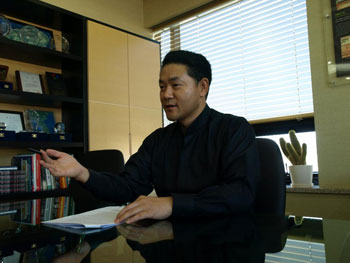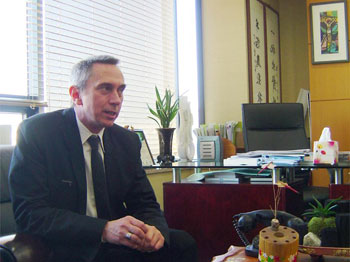찰스왈드하임 교수와 박명권 대표의 대담-1
조경가, 건축 및 도시전문가보다 경쟁 우위
랜드스케이프 어바니즘의 창시자이자 하버드대 GSD 조경학과장을 역임하고 있는 ‘찰스 왈드하임’. 국내뿐 아니라 조경설계 단일규모로서는 세계 최대규모를 자랑하는 ㈜그룹한의 ‘박명권 대표이사’. 대한민국 조경문화제 기간이었던 지난달 23일 (사)한국조경학회의 초청으로 입국한 찰스왈드하임과 2년간 하버드대 GSD 객원교수를 마치며 그와 각별한 인연을 맺고 있는 박명권 대표가 한자리에 앉아, ‘랜드스케이프 어바니즘’을 주제로 대담을 진행하였습니다.
대담의 내용은 조경과 관련분야의 통섭 및 협력이 강조되는 현시점에서 랜드스케이프 어바니즘에 대한 이해의 폭을 넓히는 기폭제로 작용 할 것입니다. 이에 라펜트 조경뉴스에서 두 명사의 대담을 총 3회(월, 화, 수)에 걸쳐 연재합니다.
이와함께 월간 <환경과조경> 12월호(통권 272호)에는 찰스왈드하임을 비롯해 영국 AA스쿨의 톰 스미스 교수, 미국 유타대학의 낼 엘린 교수, 한양대 도시대학원 조세환 교수, 서울대 환경대학원 조경진 교수 등 국내·외 석학들로부터 “랜드스케이프 어바니즘의 정의와 장·단점”을 짚어보고 “학문적 논의와 구체적인 실천사례, 조경실무에서의 적용 가능성” 등에 대해 들어보는 “5人 5色” 인터뷰가 수록될 예정입니다.
-편집자주
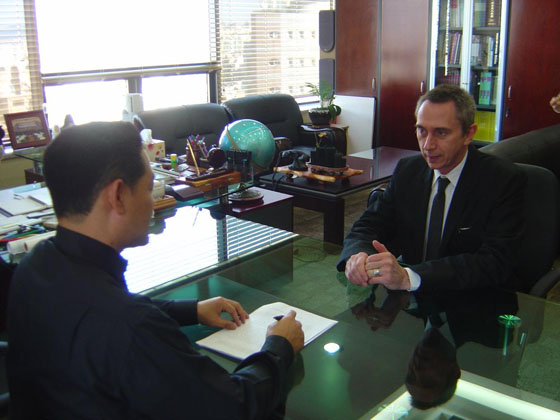
<차례> 찰스왈드하임 교수와 박명권 대표의 대담 - 관련기사 링크
1회: 조경가, 건축 및 도시전문가보다 경쟁 우위
2회: 조경, 경기불황에도 미래는 밝다
3회: 조경가, 대형 개발프로젝트의 중심적 역할해야
박명권
먼저 바쁜 일정에도 방문해주셔서 감사드립니다. 한국을 방문한 소감이 어떠신지요?
Professor Waldheim
초청해주셔서 감사합니다. 중국을 포함한 아시아 국가 몇 군데를 방문한 경험이 있지만, 한국 방문은 이번이 처음입니다. 하지만 이미 하버드대학교에서 한국학생을 만나는 것은 어려운 일이 아니며 그들을 통해 많지는 않지만 정보를 얻고 있습니다. 이번 방문 및 국제심포지움을 통해 한국의 조경가들과도 긴밀한 네트워크를 형성하게 되기를 기대합니다. 그런 점에서 오늘 둘러 본 그룹한은 사무실의 규모와 직원들의 열정, 그리고 최근 작품들에서 매우 깊은 인상을 남겼습니다.
박명권
|
한국의 많은 조경가들과 학생들이 이번 교수님의 방문과 국제심포지움에 큰 관심을 가지고 있습니다. 공식석상에서 랜드스케이프 어바니즘과 관련된 많은 논의들이 진행될 것이므로 여기서는 하버드대학교 학과장으로서의 교수님께 몇 가지 질문을 드리고자 합니다. |
▲박명권 - (주)그룹한 어소시에이트 대표 |
박명권(Q1):
전 세계 대학에 많은 조경학과들이 있지만 특히 하버드대학교의 조경학과장은 동시대 조경인들로부터 특별한 주목을 받는 자리라고 생각됩니다. 또한 과거의 학과장들이 보여주었던 것처럼 조경분야의 새로운 이슈를 가지고 계실 것으로 기대가 상당히 큽니다.
일례로 로리 올린(Laurie Olin)이 1982년부터 1987년까지 하버드 학과장으로 재임하면서 뉴욕 Bryant Park 와 같은 복원사업을 통해 조경가가 현대 도시공원의 역할과 사회적 이슈를 다루는 훌륭한 모범을 보여 주었으며, 1991년부터 10년간 하버드 학과장이었던 조지하그리브스(George Hargreaves)는 자연적 시스템의 복원과 자생적인 경관을 위한 생태적 접근을 이루어냈다는 평을 받고 있습니다.
또 지난학기까지 학과장을 역임했던 닐 커크우드(Niall Kirkwood) 교수는 브라운필드(Brownfield Sites)의 재생과 개발에 대한 활발한 연구로 산업화 이후 새롭게 대두되고 있는, 오염되고 버려진 대상지에 대한 설계적 접근방법에 체계적인 이정표를 제시하였습니다.
교수님께서는 새로운 학과장으로서 하버드의 조경교육을 어떤 차별화된 패러다임으로 이끄실 생각이신지요?
Professor Waldheim:
우선, 하버드 조경학과가 전체 조경계에서 차지하는 위상과 역사적 중요성에 부응하여 학과를 이끌어가야 함에 있어, 상당한 책임과 영광을 동시에 느낍니다. 학과장으로서 제가 설정한 목표는, 환경생태의 과정과 사회경제적 프로세스에 대한 이해를 두루 갖추고 세계 어느 곳에서든 일할 수 있는 실무능력을 보유한 선구적 조경가를 길러내는 것입니다.
이 과정에는 조경가들을 넓은 의미의 도시전문가로서 양성하여, 그간 조경이 쉽사리 접근할 수 없었던 광역적 도시 문제 해결에 대한 능력을 배양하는 것이 포함됩니다. 그러므로 이 목표는 랜드스케이프 어바니즘의 담론의 연장선상에 있습니다. 또한 조경가들이 조경의 역사에 대해 해박해야 하는 것도 필수조건입니다. 그러한 견지에서, 저는 역사와 이론 교육에 더욱 힘을 실을 것입니다.
동시에 작품을 표현하는 드로잉이나 모델에 대한 다양한 기법을 더욱 연구하고, 특히 디지털매체를 이용해 경관을 표현하는 과정에 대해 특별한 노력을 기울일 것입니다. 이러한 기반을 바탕으로, 경관디자인에 접근하는 방법으로서 생태학적 지식을 강화하고 창조적으로 재구성할 수 있는 능력을 교육할 것입니다.
박명권(Q2):
제가 알기로 찰스 교수님은 랜드스케이프 어바니즘(Landscape Urbanism)에 대하여 오래전부터 연구하고 또 책도 쓰시고 하셨습니다. 1997년 일리노이대학교에서 개최된 심포지움에서 발표된 것을 보면, 경관을 기존의 회화적 관점에서 탈피하여 일종의 기반시설로 보고 도시의 경쟁력과 재생 전략으로 조경을 새롭게 정의하는 것이 랜드스케이프 어바니즘의 기본개념이라고 알고 있는데요. 그것이 MVRDV의 엑스포 2000 네덜란드관(Dutch Pavilion Expo 2000)이나 FOA의 요코하마 터미널(Yocohama Terminal)에서와 같이 건축계에서 시도하고 있는 건축적 랜드스케이프와 어떻게 연관이 되고 주요한 차별성은 무엇인지, 간단히 설명해주시면 감사하겠습니다.
|
|
Professor Waldheim: 점점 더 많은 조경프로젝트가 실제 과거 도시설계와 도시계획이 하던 일을 수행하고 있는 것이 사실입니다. 조경가의 역량에 대한 인식의 변화는 우리가 다루는 업역의 변화를 의미합니다. 이와 동시에 주목할 것은, 건축가들 사이에서 수평적 관계에 주목하는 경향이 점증되어 왔으며, |
실제로 상당한 건축 작품들이 대지와 건축물의 물리적 접합을 꾀하거나, 건축과 대지의 상호독립적 관계를 무시하는 시도를 해 왔다는 것입니다. 제 생각에는 이것이 꽤나 생산적이고 흥미로운 논의이며, 작품 자체도 나름 이목을 끄는 구석이 있다고 봅니다.
그러나 건축가들이 언급하는 랜드스케이프와 랜드스케이프 어바니즘을 혼동해서는 안됩니다. 대지와 접합된 듯한 건축양식은 흥미롭기는 하나, 도시를 만드는 것과는 아무런 관계가 없습니다. 아마 그런 프로젝트들이 조경가들에게도 어떤 영감을 주기는 할 것입니다만, 실상 그 두 가지는 전혀 다른 담론입니다. 몇몇 사람들이 여기에 대해 혼동하는 경향이 있는데, 두 가지 논의 모두 중요하고, 어쩌면 흥미로운 것은 사실입니다.
랜드스케이프 어바니즘이 도시의 구조와 공간 및 변화과정을 다루는 반면, 건축에서 말하는 랜드스케이프는 주로 단일 건물 규모의 상대적으로 작은 공간에 대해 언급하는 것입니다. 두 담론은 비슷해 보이지만 실제로 매우 다른 출발점에서 시작하였습니다.
랜드스케이프 어바니즘의 시초는 다음과 같습니다. 즉, 건축가들이 도시 이용행태의 변화에 대해 고민하면서, 그것을 설명하는 모델로 경관을 사용하였고, 이후 경관에 녹아있는 생태학적 개념이 자연스럽게 도시의 이용행태나 부지의 상황을 설명하는데 적용된 것입니다.
이에 반해, 질문에서 언급하신 건축적 랜드스케이프라고 하는 것은, 건물을 대지의 일부로 인지하는 것을 말하고, 이것 역시 건축을 둘러싼 환경에 대한 고민에서 시작된 것은 마찬가지이나, 본질적으로 건축물의 오브제로서의 위상, 즉 이질적 물성으로서의 건물을 극복하고 수평적 복잡성을 반영하려는 몸부림이었다고 볼 수 있습니다.
엔릭 미라제스의 1992년 올림픽을 위한 바르셀로나 양궁장과, 그로부터 십년 후에 완공된 FOA의 요코하마 페리터미널 사이에는 어떤 일관된 흐름이 있다고 생각할 수 있습니다. 물론 그 사이 기간에는 네덜란드 건축가들의 작품이 이러한 사조를 대표하였습니다. 그러나 이렇게 대지와 건물의 관계를 보는 관점은 어디까지나 유럽적인 사고방식이고, 유럽에는 하나의 계보로 묶을 수 있을 만큼 다양한 작품들이 존재합니다. 이런 건물이 생태적인 방식으로 운영되는 예는 매우 드물지만, 건축계의 문화 전반에 미친 영향은 지대하다고 할 수 있습니다.
엔릭 미라제스의 바르셀로나 양궁장에서부터 이구알라다 묘지까지 나타나는 수평적 대지 구성에 관한 일련의 경향을 보다 보면 일견 랜드스케이프 어바니즘의 발전과정과 비슷하다고 느낄지 모르지만, 실제적으로는 랜드스케이프 어바니즘이 말하고 있는 도시적 관점이나 생태적 기능과는 전혀 별개의 주제입니다.
FOA의 요코하마 터미널 및 바르셀로나 야외공연장의 경우에서도 역시 고도로 심화된 수평적 프로그램을 엿볼 수 있습니다. Recovering Landscape에 실린 알렉스 월의 에세이가 그러한 주제에 대해 포괄적인 설명을 제공하는데, 그는 도시화된 대지의 프로그래밍을 설명하면서 랜드스케이프 어바니즘과 랜드스케이프를 닮은 건축물 사이의 연결고리를 밝히고 있습니다.
알렉스 월 또한 OMA에서 근무한 경험이 있고 라빌레뜨 제출안에서 다양한 프로그램 스트립을 표현한 평면을 작성했던 사람입니다. 그의 작업을 통해 건축가들이 지닌 수평적 프로그램의 다양성과 변화에 대한 관심을 엿볼 수 있고, 평면적 프로그램을 구성하는데 대한 건축가들의 접근방법 또한 알 수 있습니다.
스탄 알렌은 The Thick 2-D라는 에세이에서 수평적 평면을 다루고 지면을 디자인하는 것이 왜 오늘날 건축가의 주된 일 중 하나가 되었는지를 밝힘으로써, 랜드스케이프 어바니즘과 위에서 열거된 건물들의 접점을 시도하고 있습니다. 그렇긴 해도, 이 두 가지 담론이 매우 뚜렷하게 다른 출발점과 목표를 가지는 것은 분명합니다. 또한 자주 혼동되는 것도 사실입니다.
박명권(Q3):
1982년 건축가인 베르나르 츄미(Bernard Tschumi)가 라 빌레뜨(La Villette) 공원 공모전에서 당선된 이후 많은 건축가들이 조경과, 도시 분야의 경계를 넘나들며 활발히 활동하고 있고, 또 과거와는 달리 최근에는 이러한 전통적인 건축, 도시, 조경에 대한 영역이 허물어지고 하브리드(Hybrid) 되는 현상이 나타나고 있습니다.
이처럼 건축과 조경, 도시영역의 전통적인 이원론적인 위계구조가 해체되고, 탈장르화 되고 있는 이런 현상에 대해 조경학과장으로서 어떤 견해를 갖고 계시는지요? 또한, 우리 조경가들이 이러한 시장상황에서 우리의 영역을 지키고 더욱 발전해 나가기 위해서는 어떠한 노력을 해야 할지 조언을 부탁드립니다.

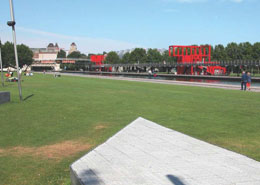
▲ 베르나르 츄미(Bernard Tschumi)의 라 빌레뜨(La Villette) 공원
Professor Waldheim:
매우 적절한 질문이며, 2번 질문과 자연스럽게 연결된 문제제기입니다.
대학원 시절에 라빌레뜨 공모전에 제출된 안들을 살펴볼 기회가 있었습니다. 아직도 기억에 남는 것은 당선안(츄미의 안)과 2등안(OMA의 안)에서 제시된 혁신적 프로그램과 새로운 부지의 변화에 관한 깊이 있는 철학이었습니다. 반면에 여타 400여개의 제출물, 특히 조경가들이 작성한 방안들의 경우 단순히 형태와 구성적 실험에 그침으로써 매우 빈약한 전망을 제시하는데 머물렀다고 회상합니다.
한편, 당시 심사결과에 대한 조경계의 반응은 분노와 우려였습니다. 건축가들에게 고유의 영역을 침범 당했다는 분위기였습니다. 이후 25년간, 건축과 조경, 도시계획 프로젝트의 경계가 점점 흐려져 왔습니다만, 저는 이것이 당연하고 바람직한 결과라고 생각합니다. 왜냐하면 이러한 추세가, 2차대전 이후 가속화된 극단적 전문화 경향에 대한 반발이기 때문입니다.
60, 70년대를 규정하는 전문분업화는 실상 건축 전반의 디자인 산업과 어울리지 않는 구석이 있었습니다. 우리는 그간 조경가는 건축가와 다르다는 것을 강조해 왔습니다. 그런 입장의 연유를 이해하지 못하는 것은 아니지만, 방어적이고 소극적인 자세라는 것도 인정해야 합니다. 건축가와 조경가, 도시계획가 모두 디자이너일 뿐입니다. 우리가 처한 막대한 문제들과 가능성은 공동으로 대처할 사안이며 결코 어느 한 분야에 국한된 문제일 수 없습니다.
GSD의 조경학과장으로서, 저는 학생들이 다른 디자인 분야에 대해서도 상당한 수준의 지식과 최신의 안목을 갖기를 원합니다. 또한 건축가나 도시계획가들과 협업함에 있어서 충분한 자질을 갖추기를 바랍니다. 조경을 전공하는 학생들은 물론 조경의 특화된 지식과 기술에 대해 능수능란한 동시에 건축, 도시 문제에 대한 기본적 소양을 키워야 합니다. '경계의 허물어짐이 조경의 영역을 침식한다'는 관점을 벗어나, 오히려 조경이 더욱 강성해질 수 있는 기회로 보아야 합니다.
많은 조경가들이 단지 건축, 도시와의 협업을 넘어, 그들과의 경쟁에서 우위를 보이고 있습니다. 그것은 조경이 건축, 도시와 차별화된 접근방법과 디자인 교육과정을 가지고 있기 때문입니다. 따라서 교육과정의 측면에서 볼 때, 우리의 강점인 생태학과 식물에 대한 지식, 경관의 변화에 대한 이해와 경관생태학적 관점에 대한 훈련에 매진해야 함은 당연합니다.
그러나 그에 못지않게 중요한 것은, 세계에서 일어나고 있는 디자인 경향에 관심을 갖고 충분히 숙지하는 것입니다. 지금까지 많은 사람들이 조경을 디자인의 일부로 보지 않고, 일종의 응용과학으로 인식해왔습니다. 조경과 생태학을 불가분의 관계로 보고, 조경프로젝트를 하나의 생태학적 디자인으로 여기는 풍토는 일면 공감이 가는 측면이 있습니다. 그러나 결과적으로 볼 때 그것은 패배할 수 밖에 없는 관점이었습니다. 왜냐하면 현 시대에 조경가가 그 존재의의를 가지고 핵심적 역할을 수행하는 것은 오로지 전체적인 디자인의 맥락에서만 가능하기 때문입니다.
(11월 9일(화), 2회에 계속)

Park myung-kweon:
I appreciate your visit to Group HAN and Korea.
What is your feeling about visit to korea?
Professor Waldheim:
Thank you for inviting me. Actually I have been in Asia, including china. but This is my first visit to Korea. I have met many korea students at Harvard and I got little information from them. Through this symposium, I expect cooperate closely with korea landscape architects.
When I got here, I was very impressed by the large-scale company, employees`s passion and work of Group HAN.
Park myung-kweon:
Many people take an active interest in your visit and this symposium. The symposium presentations will discuss about Landscape Urbanism.
So I have several questions for you as the Dean of the department of Landscape Architecture at Harvard.
Park myung-kweon(Q1):
There are many universities with Departments of Landscape Architecture in the world, but I think that the position of Chair of the Department of Landscape Architecture at Harvard GSD has the special attention of contemporary landscape architects. Also, as your predecessors did, people expect you to bring innovative perspectives to the field. For example, Laurie Olin showed to landscape architects the great role of the contemporary urban park and how to deal with social issues through the Bryant Park Project during his term in Harvard from 1982 to 1987. George Hargreaves, Department Chair for 10 years from 1991 has received good reviews regarding his ecological approach to natural system recovery and autogenous landscape which lead to ecological and continuous landscapes. And Niall Kirkwood, who held the position until last semester, developed a systematic milestone in the design approach to former industrial or disturbed land with vigorous studies of recycling and development of brownfield sites, which is becoming a main post-industrialization issue. As the new Department Chair, what is your framework for guiding the education of landscape architecture at Harvard GSD?
Professor Waldheim:
First I would say, it’s a great honor and a privilege and a great responsibility to have this role, which is to shepherd the department forward, given its’ great history and its’ importance in the field. I think this is a great honor and a great responsibility. My primary goal is to train future leaders in landscape architecture who are prepared to go anywhere in the world and practice at the intersection of environmental and economic processes. So, of course, part of this means training landscape architects to work as urbanists and to take on roles which historically they have only occasionally had access to over the many years. This of course has much to do with the conversation of landscape urbanism. It also has to do with training landscape architects to be intellectually curious and grounded in the history of their discipline. So we will be doing more in terms of history and theory. It has also to do with the way in which we represent our work. We’re focusing very much on the kinds of drawings and models that we make and in particular forms of digital media, the computer and its’ relationship to landscape representation. And then, finally, I would say that we’ll be renewing and strengthening our commitment to ecology as a framework through which to approach landscape design.
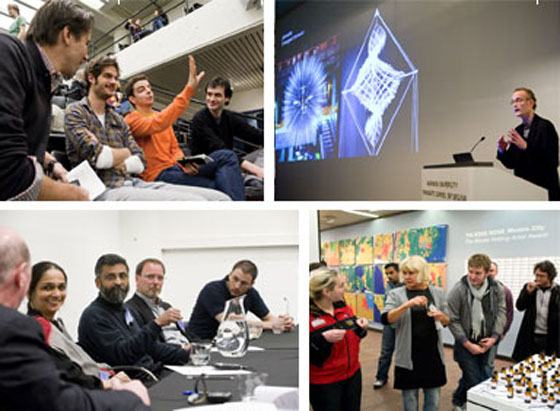
▲ 하버드대학교 GSD(출처: http://www.harvard.edu/)
Park myung-kweon(Q2):
As we all know, you have conducted research and written books about Landscape Urbanism. According to your speech at the Landscape Urbanism Symposium in 1997 at the University of Illinois at Chicago School of Architecture, a fundamental concept of Landscape Urbanism is the redefinition of Landscape Architecture as competitive between cities recycling strategy by breaking the existing pictorial landscape perspective and recognizing as a kind of infrastructure. I would appreciate if you explain to us the differences and relationship between Landscape Urbanism and Architectural Landscape which is acting in the field of architecture though such projects as the Dutch Parvilion EXPO 2000, by MVRDV and FOA's Yokohama Terminal.
Professor Waldheim:
First of all, yes I think it’s true that landscape architects are increasingly taking on the role historically associated with urban design or urban planning and I think this redefinition of what the landscape architect is capable of doing does change much of the context for the work that we do. At the same time and in parallel has been an interest by architects to focus on the horizontality of their work and there is a genre of architectural project which conflates or mistakes a building for ground. I think that’s a productive and interesting conversation and much of the work is compelling in its’ own right. But I think it would be a mistake to confuse the two: that in fact, buildings, smuggled underground, while interesting, are not really the same thing as the making of the city and while they may share certain inspirations, they’re really very, very different operations. I think this has been an area of some confusion. I think both lines of work are important or maybe interesting. One has to do, really, with the structure and the space of the city and its’ processes and the other has to do more with the object scale or the scale of the individual building site. I think they come from similar but different origins. Landscape urbanism emerges when architects begin to think about programmatic change in the city and landscape as a model of that change and then begin to apply ecological thinking to program but also to site. What you call ‘architectural landscape’, that is, building buildings as ground, I think also comes out of an interest in the relationship between architecture and the environment but has more to do with architectures’ anxiety about its’ object status, the highly configured horizontal surface. There’s probably a continuity of thought between the work of Enric Miralles, the archery range of the Barcelona Olympics, and Foreign Architects Offices’ Yokohama Terminal. Between those two, of course, the Dutch have been very active. But in principle it has been a European interest to look at the relationship between buildings and their grounds and there’s a whole genealogy, a whole kind of family tree, of buildings that are engaged in this way. Only occasionally do those projects operate in any ecological way but they’re also interesting and compelling in terms of what they contribute to architectural culture. And so, if you begin by thinking about the configuration of the ground at the archery range of Enric Miralles and then continue that through his project for the Igualada Ce During the competition for La Villette he made those cartoons of the individual strips of landscape of different programs and so in Alex Walls’ work you see an interest in, on the one hand, programmatic change, as evidenced by the OMA competition for La Villette, but also an interest in the programming of the horizontal surface as a kind of primary architectural act. If you look at Stan Allens’ essay The Thick 2-D, he has written recently commenting on how the horizontal surface and articulating the ground plane is one of the primary architectural acts today. And this is another point that connects landscape urbanism with these architectural projects. Having said that, I think the origins and the goals of these different projects are really quite distinct, but they have often been mistaken, one for the other.
Park myung-kweon(Q3):
After Bernard Tschumi won the Parc de la Villette competition in 1982, the work of many architects began to blur the line between Landscape Architecture and the Urban Field. Also, unlike the past, territories of traditional architecture, urban and landscape architecture are collapsing and becoming hybridized. As Department Chair, what is your opinion about this kind of situation? And would you give some advice as to how we landscape architects can protect and develop our territory in this market situation?
Professor Waldheim:
I think that’s a good question and a nice transition from question 2. I remember being in graduate school and studying the reception of La Villette and I remember going back and looking at the projects and the submissions and being struck by how the first and second prize entries were so sophisticated in their use of programming and their idea about change and that many of the other entries, the 400 some entries, especially those by landscape architects, many of them were quite weak because they were based on an idea of composition or form. But I also remember in the reception of this, the anxiety and often the anger from landscape architects who felt this was unjustified. It was architects taking their work. Over the last twenty-five years or more, I would say that increasingly we’ve seen the division or the boundaries between architectural commissions, landscape commissions, and urbanism projects to be increasingly fuzzy. I think this is actually a very natural and healthy outcome. It’s a reaction to the hyper-specialization of the post-war period. In the 1960’s and 70’s we had a kind of rush to specialization and I think that specialization hasn’t always served our discipline very well. We’ve trained a generation or more of landscape architects to identify themselves as ‘not architects’. And while I understand the conditions that produced that desire for definition, I also think that that is a slightly defensive position and that we, really, all of us as design professionals, face enormous challenges and opportunities and those challenges rarely present themselves along specific disciplinary boundaries. Now, with respect to the Graduate School of Design and the Department of Landscape Architecture, I’m committed to continuing our tradition of training landscape architects to be quite fluent and literate in contemporary design and quite comfortable both commissioning and collaborating with the leading architects and planners of the day. In that context I think we need to train landscape architects well within their specialty, to be outstanding in what they do, but also to be equally comfortable working in the context with architects and urban designers and urban planners. So rather than framing it as ‘the collapse of boundries will lead to a loss of our profession’ I would rather think that the strength of our profession is through design culture because I think a part of what you see is that, increasingly, landscape architects are quite comfortable working alongside and with and competing against architects and effectively, maybe bringing a different set of tools, but those tools are often putting us in a position where we can actually win projects because we have a different training.
And so as a result we have to focus, in the educational process, on the disciplinary depth, the particular strengths in ecology, in plant material, in landscape processes, and landscape ecologies. But equally, I think we have to train landscape architects to be fluent in contemporary design globally. For a generation or more, the field tried to define itself as outside of design culture and as a kind of applied science. And that project, the project of mistaking landscape architecture for a discipline of ecology was very heart-felt but I think it has been a failure, primarily because I think it’s now through design that landscape architects have found a new relevance and centrality.
(2회에 계속)
